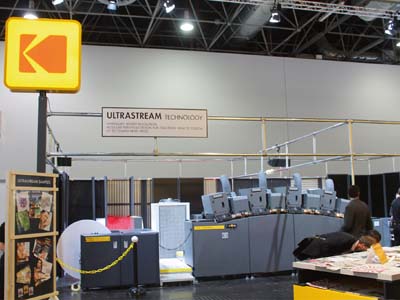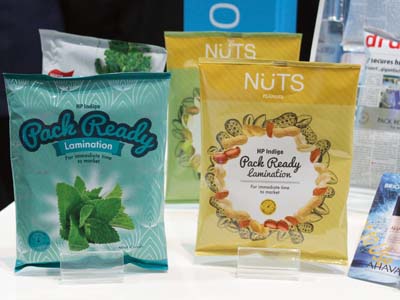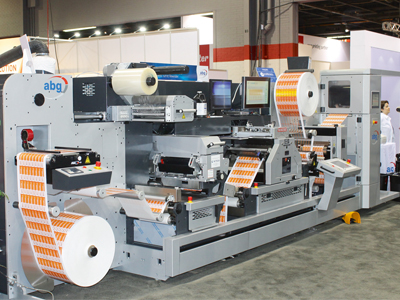ABG’s Fast Track Die station mounted on a finishing line
As the year draws to a close, we look back at 2016 in an attempt to identify the trends and technologies that helped shape the landscape of digital print for labels and packaging. By Neel Madsen.
It was a busy year, one that seems to have flown by in a blur, but it is time to take stock of what we learned in 2016 and what we can carry with us into 2017. Being a drupa year, there were significant new developments in terms of equipment – bigger presses, faster presses, more sophisticated finishing, new ways of decorating, more collaboration between suppliers creating hybrid machinery and software integration, while everyone connected with The Cloud.
Top trends
Electrophotography (EP) printing presses started going faster. HP Indigo put two print engines together to form the 8000 press, which can achieve up to 80 m/min in enhanced productivity mode and 60 m/min printing the standard four colours. Xeikon’s most productive press in its class, the CX3 press has now reached 40 installations and will forever be associated with speed through its original name, the Cheetah.
Although it is building in momentum, inkjet is in the same position electrophotography was for many years. It took a while for EP digital printing to gain the recognition it deserves, and I still encounter the odd person who will happily claim that digital print quality is not good enough and it will never catch on, but they are far and few between nowadays. Instead they now say the same about inkjet, but the combination of high quality and speed that inkjet offers, means that it is a force to be reckoned with, and for some applications, it is the more suited technology. Inkjet presses are selling at a steady pace; expect this to pick up and to see many more installation next year.
Adding value with digital inline finishing is perhaps one of the newest trends. In 2016, we have seen both Xeikon and HP Indigo offer various digital modules for combination printing, while manufacturers of converting lines are increasing automation and speed to keep up with digital presses. For the label printer it is about creating a unique offering and this can often be found in the finishing process, whether it is using variable data in a new way, adding shiny or tactile effects or delivering faster than anyone else.
Digital also reached into new markets, most prominently corrugated. drupa was awash with announcements from manufacturers getting in on the action. It is of course a natural progression to extend digital into this sector – following on from flexible packaging and folding cartons – but it will be interesting to see how quickly it takes off and how brand owners will utilise these new capabilities.
Collaborations just makes sense and is perhaps nothing new, but there is certainly much more to be found in our industry. Hybrid presses continue to be brought to market in a variety of forms. Inkjet modules can be added to any conventional press or incorporated into the finishing line to create an all singing all dancing production machine. The jury is still out in how many of hybrids the market needs and the next few years will no doubt see a few lost along the way, but again expect to see more installations in 2017.
And then of course we are now all sitting on a cloud, or rather we should all be in ‘The Cloud’. Users can now connect to their workflow and management information software wherever they may be in the world. Approving proofs is easier than ever and sending files to production plants across the globe is at your fingertips. No rest for the wicked.
TOP TECHNOLOGIES
So which products caught our eye in 2016? Here, in no particular order, we present our top 10 technologies. Some were launched this year or at the tail end of last year, while others made an impact, were further developed to offer something special or truly found their feet in 2016 …
Laser scribe
Late stage customisation with inline printing, or laser imaging, by DataLase caught everyone’s attention at drupa with its almost magical creation of printed text in the blink of an eye. The technology entered the market some time ago, but is now ramping up with several collaborations in place between DataLase and other industry suppliers. The future potential is vast.
Tech spec: A special laser-sensitive pigment is incorporated into an ink or coating, which can be applied to a wide variety of substrates by conventional print techniques. A laser beam then writes onto the substrate effectively creating a label, as late in the process as at the point of packing or filling.
One stop shop
With numerous new inkjet presses coming to market, Global Graphics was aware of the need to come up with a package of software products that specifically targets the manufacturers, along with a service team to help during the development phase. Fundamentals is the missing link which promises to optimise the print quality of an inkjet press and drive it to success.
Tech spec: Fundamentals includes a number of software components, including an OEM version of Cloudflow from Hybrid Software. Other components are Label Layout Station for estimating and planning single or multi-gang orders on roll to roll at the start of the print workflow; the Harlequin RIP for feeding pages to the press integrated with Cloudflow; the ScreenPro standalone multi-level screening engine for addressing quality defects; Harlequin ColorPro for consistent and predicable colour for a wide range of workflows; ProofScope for soft proofing and Mellow Colour for colour and print quality management.
Fastest on the track
It’s fast and it’s furious – well perhaps not furious, but the new Fast Track Die from AB Graphic International is claimed to be the world’s fastest semi-rotary die-cutting system, and we haven’t seen any other contenders for that title yet. The patent pending die-cutting system was developed for the Digicon 3 finishing line to keep up with the speed of digital presses.
Tech spec: Running at speeds of up to 150 m/min in semi-rotary mode, the Fast Track Die is more than twice as fast as other systems. It has a repeat range of 250-508 mm.
Streams of ink
Kodak’s UltraStream is ultrafast and was shown as a technology demostration at drupa where it had been integrated with a Uteco press platform. Smaller drop sizes produced using less energy and precisely placed, along with water-based inks, mean the technology gets bonus points for being green.

Tech spec: A continuous inkjet method that employs microelectro-mechanical systems (MEMS) and metal-oxide semiconductor (CMOS) technology. Its silicon nozzle plate consists of an array of 2560 nozzles. The droplet generation rate enables a resolution of 600 dpi in the paper cross-track direction and 1800 dpi in the paper direction, with sub 4 pl droplets. This equates to an image of 1200 x 1200 dpi at speeds of over 152 m/min.
No stretching
The 2016 upgrade to FFEI’s Graphium press impressed us with the new capability to handle very thin and tricky filmic substrates, giving printers what they have been asking for and opening up new avenues to increased profits while saving on waste. Adding orange was also a smart move, making this hybrid machine even more flexible with loads more colours within reach.
Tech spec: Developed with Edale, which provided the flexo part of the press, the Graphium can now handle thin films down to 12 microns. Carbon fibre roller, LED curing and new software make up the Dynamic Sync Technology that ensures perfect registration. Fujifilm’s new orange ink is an option that can replace one of the whites in the six channel set up to expand the colour gamut.
Time at the bar
The Print Bar from Xaar is small yet powerful and it is finding traction as a bolt-on to existing printing presses and finishing lines, or designed into new builds. Tactile labels will always attract consumers; we want to touch and feel; and once the product is in our hands, we usually buy. This little magic box is a nifty way to add value to your labels with high build effects, spot varnish and even metallic inks.
Tech spec: The system uses Xaar 1002 printheads with TF technology (GS6, GS12 or GS40 depending on applications) and can be supplied in widths from 70 to 560 mm. Prints at speeds up to 75 m/min as standard in resolutions up to 720 dpi, greyscale. UV LED pinning and curing is supplied by Phoseon and it is optimised for coated and uncoated paper, PE, PP and PET films, and foils.
Silver delight
The TrojanTwo memjet-driven digital press is literally selling like hot cakes. With some 200 machines now installed, there is no sign of interest waning in this little silver number from Denmark. Several other manufacturers have rebadged the press to include it as part of their line up. This size of production press fills a gap in the market for entry-level affordable machines that deliver on quality.
Tech spec: The TrojanTwo can print web width of 50 to 250 mm at speeds up 18 m/min in max 1600 x 1600 dpi resolution. It features direct servo drive with precision planetary gearheads and prints CMYK with 1 to 2 pl drops. Billed as an out-of-the-box solution ready to print in a few hours.
Game ready
Rendering your design in real time was the USP from Creative Edge, whose iC3D software has been developed with the help of programmers more at home in the gaming world. So you could say that version 4 was a true ‘game changer’: no more waiting for the design to render and the result was photorealistic images of the packaging design.
Tech spec: Version 4 included Ray Tracing to accurately simulate effects of light on virtual objects for photorealistic, ultra-high resolution, accurate photo studio effects; 3D Model Interiors for realistic liquid filling at any angle; Light Map Editor to re-create studio lighting, with editable highlights and shadows; Dynamic Backgrounds for real-time merging of 2D photo images with 3D designs; and Perspective Control to match 3D model perspective to 2D photo backgrounds.
Food safe beams
There is an urgent need to solve the issues of ink components potentially migrating into food. One solution (and it is a problem that needs one) came from ebeam Technologies at drupa. The company launched a new energy-curing system for food-safe inkjet printing that has eliminated the need for photoinitiators in the inks and also miniaturised the electron beam hardware making it easier to integrate.
Tech spec: The ebeam Inkjet Dryer (EID) is a compact, sealed lamp that produces a precisely controlled beam of electrons to instantly cure EB inks. It has so far been shown at drupa and Labelexpo Americas integrated inline with PPSI’s DICE inkjet printer using EB-curable inks provided by KAO Collins Inkjet.
Ready for packaging
It could have been called ‘The Year of the Digital Pouches’ as new systems came to market to take advantage of the SUP’s shelf and brand owner appeal. HP’s Pack Ready system was one of them and it made an impact at drupa. It aims to helps printers not well versed in lamination move into the flexible packaging market.

Tech spec: This post-print converting process offers lamination with no added curing time, combining HP Indigo’s digital print with Karlville’s lamination machine and pouch-making line. Converting speeds go up to 100 m/min and film widths are between 300 and 762 mm. Printing on off the shelf material is combined with special Pack Ready lamination film.






